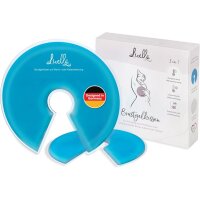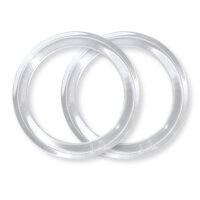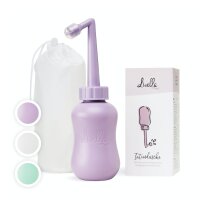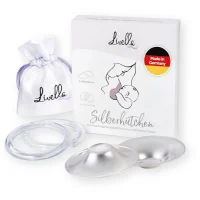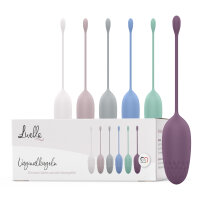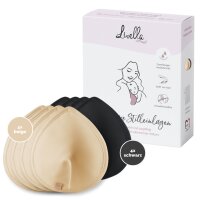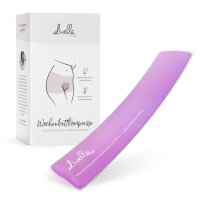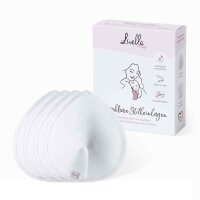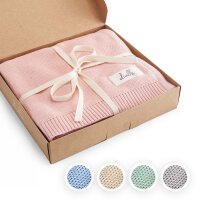Many women develop anxieties in pregnancy that there could be something wrong with their baby. The aim of the recommended antenatal checks and appointments is to monitor the baby’s healthy development and detect problems early on.
Usually, antenatal care check-ups don’t show any abnormalities. In some cases, however, prenatal screenings indicate that the baby might have a condition. Further tests are then needed for confirmation. One of these tests is the so-called chorionic villus sampling test (short: CVS).
What is chorionic villus sampling? How does it work? What does CVS test for? How reliable are the results? What are the risks of sampling tissue from the placenta?
Table of content
What is chorionic villus sampling?
When is chorionic villus sampling necessary?
How much does chorionic villus sampling cost?
What does the chorionic villus sampling procedure look like?
How to understand chorionic villus sampling test results?
Chorionic villus sampling vs. amniocentesis
Chorionic villus sampling: risks, advantages and disadvantages
Chorionic villus sampling: key facts at a glance
What is chorionic villus sampling?
Chorionic villus sampling (sometimes also referred to as chorionic villus biopsy) is an invasive prenatal diagnostic test. It is performed when prior screening tests indicate that the baby might have a chromosomal disorder (e.g. trisomy 13, 18 or 21).
Put simply, chorionic villus sampling is the process of removing tissue from the placenta, i.e. the chorion. The sampling is then tested for chromosomal abnormalities in a laboratory. The cells from the placenta are identical to the baby’s cells, which is why analysing the chromosomes in the placenta cells allows scientists to draw conclusions about the baby’s health.
A chorionic villus sampling test can also be used for screening for certain metabolic diseases. The test can be performed as early as 11 or 12 weeks of pregnancy. Taking the test earlier is not recommended from a medical point of view.

When is chorionic villus sampling necessary?
Mums-to-be often have many questions regarding CVS. One of these questions is when a chorionic villus sampling test is actually done and for what purpose.
Chorionic villus sampling is a prenatal diagnostic method that is used for diagnosing chromosomal disorders in the baby. Since sampling tissue from the placenta requires ‘invading’ the mother’s body (hence the term ‘invasive’ medical intervention), it is only performed if the test is deemed medically necessary.
This means that CVS is not part of standard antenatal care. Instead, it is only performed if:
- there is a family history of certain hereditary diseases.
- other prenatal screening tests indicate that the baby might have a condition (e.g. an ultrasound scan or a blood test in pregnancy).
- the mother has already had a child born with a chromosomal disorder.
How much does chorionic villus sampling cost?
Many future mothers are concerned about the cost of the medical examination. So, how much does it cost to have chorionic villus sampling? The good news is: If the test is considered medically necessary, it is offered to the mum-to-be without additional costs.
However, if the mother decides to have the test done in a private healthcare facility without there being any medical necessity, she needs to pay for the fees and additional costs herself.

What does the chorionic villus sampling procedure look like?
So, how does chorionic villus sampling work? Prior to the examination, there will be an in-depth medical consultation. During the consultation, the healthcare professional who performs the test will not only describe the procedure, but will also talk about potential risks and explain what the test results mean for the mother and her baby.
Deciding whether to have CVS or not is an important decision to make and mums-to-be should make sure to get all the professional support they can get to make an informed decision. Future mothers who struggle with the decision may find it helpful to reach out to Antenatal Results and Choices (ARC), which is a charity specialising in supporting women on different issues surrounding pregnancy screening tests.
Once the mother has given her approval for having the test, the healthcare professional can start the procedure. In the first step, an ultrasound scan is performed to locate the placenta and check the baby’s position in the mother’s womb. Based on the position of baby and placenta, the healthcare professional will choose where to insert the needle to get the sample.
The needle is then inserted through the abdominal wall until it reaches the placenta from where the sample is taken. During the whole time, the position of the needle and the baby is monitored via ultrasound. The procedure itself typically doesn’t take longer than a couple of minutes. Finally, the sample is sent to a laboratory for testing.
An alternative to having a transabdominal CVS as described above is the so-called transcervical CVS. In the case of a transcervical CVS, the sampling is performed by inserting a tube through the mother’s vagina and cervix to reach the placenta.
How to understand chorionic villus sampling test results?
In contrast to ultrasound scans in pregnancy, the results aren’t available immediately. That’s because the cell sample from the placenta first needs to be sent to a laboratory for testing. First results might be available within a couple of days. However, it often takes two to three weeks for the final results to arrive. But what do CVS results actually mean?
Analysing a cell sample from the placenta almost always provides a clear answer to the question of whether or not the baby will be born with a genetic or chromosomal condition. The placenta sample can also be tested for certain hereditary diseases.
But how accurate is chorionic villus sampling and how reliable are the results? Antenatal screening tests like a nuchal translucency scan or non-invasive prenatal testing (NIPT) only calculate the likelihood of a condition in the baby. Chorionic villus sampling, however, delivers a clear diagnosis in almost all cases.
In some exceptional cases, the cells in the placenta may show a different structure of the chromosomes, which means that it is not possible to make a conclusive diagnosis.
Chorionic villus sampling vs. amniocentesis
Chorionic villus sampling is not the only prenatal test that can be used for diagnosing chromosomal or genetic conditions. The second diagnostic method used in screening for Down’s, Edward’s and Patau’s syndrome is amniocentesis, also known as amniotic fluid test. But what is the difference between amniocentesis and chorionic villus sampling?
During amniocentesis, a long needle is inserted into the amniotic sac to get a sample of amniotic fluid which is then analysed in a laboratory. Amniotic fluid contains cells from the baby which can be examined to check for changes in the number and structure of chromosomes.
Chorionic villus sampling and amniocentesis are both invasive diagnostic methods that aim at sampling tissue or fluid that contain cells from the foetus to check for genetic or chromosomal conditions.
Chorionic villus sampling: risks, advantages and disadvantages
Given its classification as an ‘invasive’ diagnostic method, chorionic villus sampling often causes a feeling of uneasiness among mums-to-be. In fact, having a CVS carries certain, albeit low, risks for mother and child.
In theory, there is always a certain risk of the baby getting injured by the needle. However, given the fact that the position of both needle and baby is monitored via ultrasound throughout the entire procedure, this is a negligible risk. Also, there is a low risk of miscarriage (below one percent) or infection resulting from the needle insertion.
As a diagnostic method, chorionic villus sampling has different pros and cons. One of the advantages of CVS compared to amniocentesis is that it can be performed very early in pregnancy and that results are often available sooner.
Chorionic villus sampling is possible from 11 weeks of pregnancy, while amniocentesis can only be performed starting from 16 weeks. CVS results are often available within a couple of days, while amniocentesis results often take a little longer.
However, there are also some drawbacks to having CVS. For one thing, the sampled cells from the placenta can show different chromosomal structures than the baby’s cells. In this case, it’s not possible to get conclusive results and the procedure must be repeated.
For another thing, CVS can lead to abdominal pain shortly after the procedure. Bleeding or amniotic fluid loss are also possible. In case of complications, it’s important to consult a doctor as soon as possible.
Chorionic villus sampling: key facts at a glance
- Chorionic villus sampling is an invasive diagnostic method that is used in antenatal care.
- CVS tests for chromosomal or genetic conditions in the unborn baby.
- The procedure involves inserting a needle into the placenta to remove a sample of tissue. Placenta tissue contains cells from the foetus which are then analysed in a laboratory.
- The test is only carried out if there is an increased risk of having a baby with a condition.
- CVS is not entirely risk-free. For instance, there is a low risk of miscarriage after having the procedure.
- The test itself is preceded by an in-depth medical consultation that also highlights possible consequences of the final results.
References
- Invasiven_Flyer_Deutsch_web.pdf (uk-essen.de)
- Chorionzottenbiopsie (Entnahme von Mutterkuchengewebe) | Apotheken Umschau (apotheken-umschau.de)
- Amniozentese: Wann macht man eine Fruchtwasseruntersuchung? (livella.de)
- Was ist Pränataldiagnostik? - familienplanung.de
- Plazenta-Punktion - familienplanung.de
- Chorionic villus sampling - NHS (www.nhs.uk)




